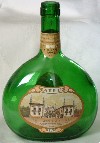Drinking in the 70s

Watney's Red Barrel and Party Seven are everyone's idea of drinking in the 70s. It was also the decade of the growing consumption of lager and branded wines, such as Mateus Rosé, Blue Nun and Black Tower.
Keg v Cask
A battle was raging for the hearts and minds of Britain's drinkers in the 70s. It was a typical struggle between two equal and opposite forces - progress, in the form of pasteurised keg bitter and tradition, in the form of the Campaign for Real Ale (CAMRA). At the beginning of the decade, keg bitter dominated Britain's pubs. Brands such as Watney's Red Barrel, Double Diamond, Younger's Tartan, Whitbread Tankard, Worthington 'E' and Courage Tavern were the taste of the 70s. In the end CAMRA won and as far as I know none of these "classic" 70s beers are still in existence.
All the same, the advertising slogans from some of these keg bitters have almost entered the language. Most people know that "Double Diamond works wonders" and that Whitbread Trophy is "the pint that think's it's a quart".
The 70s was also the age of lager. The British form of this continental drink was increasing in popularity every year. Top brands from the 70s were Carling Black Label, Skol and Harp. Most lagers from the 70s are still available today - so you can try a taste of the decade!
Mateus, Blue Nun and Martini

Think of 70s wine and most people think of Mateus Rosé, a slightly fizzy pink wine. In the 70s the bottle often ended up as the base for a lamp. In spite of some wine pundits comments, it is actually quite drinkable and you can still buy it, but the makers decided that the ironic 70s' charm of the bottle was not suitable for today's market and they changed the label design. The wine is the same though!
The other favourite from the decade, Blue Nun, is still around. Sweet German wines were popular in the 70s and 80s. Our palates though, have moved onto drier wines. Black Tower was another wine with a distinctive bottle that was a big hit in the 70s.
The 70s would never have been complete without Martini - "Any time, any place, anywhere". The heavily promoted Italian vermouth sold well throughout the 70s; most people's drinks' cabinets contained a bottle. Another firm favourite was Advocaat, used to make the favourite Christmas cocktail, the "Snowball".
A snapshot of 1970s' tastes in alcohol
This list of drinks from Peter Dominic Wine Shops from 1973 gives an idea of Britain's favourite drinks in the 1970s.
Wine
- Carafino Rouge (1 litre) - 67p
- Beaujolais Baron - 67p
- Valpolicella Belvedere -63p
- La Cour Pavillon - £2.25
- Chianti Classico - £1.20
- Liebfraumilch Little Rhine Bear - 83p
- Le Piat de Beaujolais - £1.10
- Chanterelle Brut - 89p
The selection includes some 1970s' favourites including Boudeux and Beaujolais. There is Liebfraumilch from Germany and the Italian Chianti Classico came in the traditional whicker chianti bottle.
Sherry and fortified wine
- Croft Distinction - £1.74
- Croft Original - £1.25
- Domecq Double Century - 95p
- Dubonnet - 99p
- Crabbie's Ginger Wine - 59p
- Cinzano Bianco - 96p
- Martini Red - 94p
- Fratelli Dry (Vermouth) - 88p
The other favourite sherry from this era was Harvey's Bristol Cream.
Beers and ciders
- Dominic Vintage Cider - 17p
- 3 cans Harp Lager - 9p each
- Pilsner Urquell - 17p
- Watneys Party Seven - 79p
Whiskies
- Haig - £2.39
- Johnnie Walker Red Label - £2.39
- J & B Rare - £2.53
- Bell's - £2.52
Haig was Britain's best-selling whisky in the 1960s. This changed in the 1970s. Teachers and Bell's were gaining ground on Haig and surpassed it by the end of the decade.
Other spirits
- Dry Cane Rum - £2.75
- Smirnoff Vodka - £2.48
- Gilbey's London Dry Gin - £2.39
- Booth's Gin - £2.43
- Bols Advocaat - £1.69
- Hennessy Fine Cognac - £3.99
- Gilbey's Triple Crown - £1.09
- Southern Comfort - £4.36
- Drambuie - £3.43
Mixers
- Schweppes Bitter Lemon - 5½p
- Canada Dry Ginger Ale - 5½p
- Hunts Tonic ½litre - 8p


Comments
Thanks for the memories
Babycham.
Sounds like kirsberry, a Danish cherry flavoured liquer. It's still available from Amazon, amongst others, but needless to say more expensive these days.